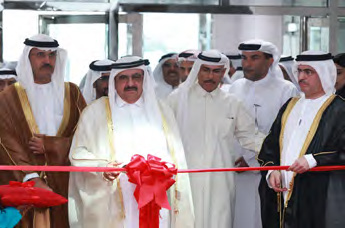Reported to be the largest government building in the world to be awarded LEED Platinum
Reported to be the largest government building in the world to be awarded LEED Platinum
H.H. Sheikh Hamdan bin Rashid Al Maktoum, Deputy Ruler of Dubai, Minister of Finance, and President of the Dubai Electricity and Water Authority (DEWA), on February 19, 2013, opened DEWA’s new sustainable building. The inauguration ceremony was attended by dignitaries, including H.H. Sheikh Ahmed bin Saeed Al Maktoum, Chairman of the Supreme Council of Energy in Dubai; H.E. Matar Humaid Al Tayer, Chairman of the Board of Directors of DEWA; H.E. Saeed Mohammed Al Tayer, Managing Director and CEO of DEWA; members of the board; Executive Vice Presidents from DEWA; senior officials and VIPs from Ministries and Government Departments; and media representatives.

H.H. Sheikh Hamdan Bin Rashid Al Maktoum opening DEWA’s sustainable building
“We dedicate this achievement to His Highness Sheikh Hamdan bin Rashid Al Maktoum,” Saeed Mohammed Al Tayer said. He added that, as per Sheikh Hamdan’s directives to set a clear roadmap and integrated framework for the construction of the building, the DEWA Sustainable Building was now recognised as the largest government building in the world with a LEED Platinum rating from the US Green Building Council. “The DEWA Sustainable Building achieved 98 out of 110 points,” Al Tayer revealed.
In an exclusive interview with Climate Control Middle East, Abdullah Obaidullah, Executive Vice President of Water and Civil Engineering Division, DEWA highlighted a few of the salient features of the new DEWA Sustainable Building: “The glass panels used in the building are specially ordered from a German company, and are designed for heat rejection,” he said. “The specifications were assigned by our green consultants, Green Technologies.” He added that because the glass panels helped in rejecting the heat from the outside, the temperature inside the building could be kept within the range of 23°C to 24°C. He also pointed out that the entire building was installed with LED lighting systems and was equipped with motion sensors.
The building management system, he further elaborated, controlled around 90% of the functions of the building. “The system can control the chillers, the AHUs, the fans, the ventilation fans for the basement and the solar power, among others,” he said. Though already an integral part of the building’s operation, Obaidullah pointed out that the systems were in the process of being fine-tuned and more data was being gathered to find out the best way to operate the new building. “It will take some time, as it is an evolving knowledge,” he explained.
Regarding the power being generated by solar panels installed at the rooftop of the building, Obaidullah elucidated that all the power being generated went directly to the grid of the building, and that there was no special power allocation to any system within the building. He said that this was to avoid wastage of power in situations when allocated power was not consumed.
In an official communiqué, DEWA highlighted other sustainability features of the new Sustainable Building. Listed below are a few of them:
According to DEWA, sustainability standards have been a priority throughout the construction process of the building and in the choice of the materials used, which have helped it achieve its strategic goals and attain recognition for its projects, both locally and internationally.
Copyright © 2006-2025 - CPI Industry. All rights reserved.